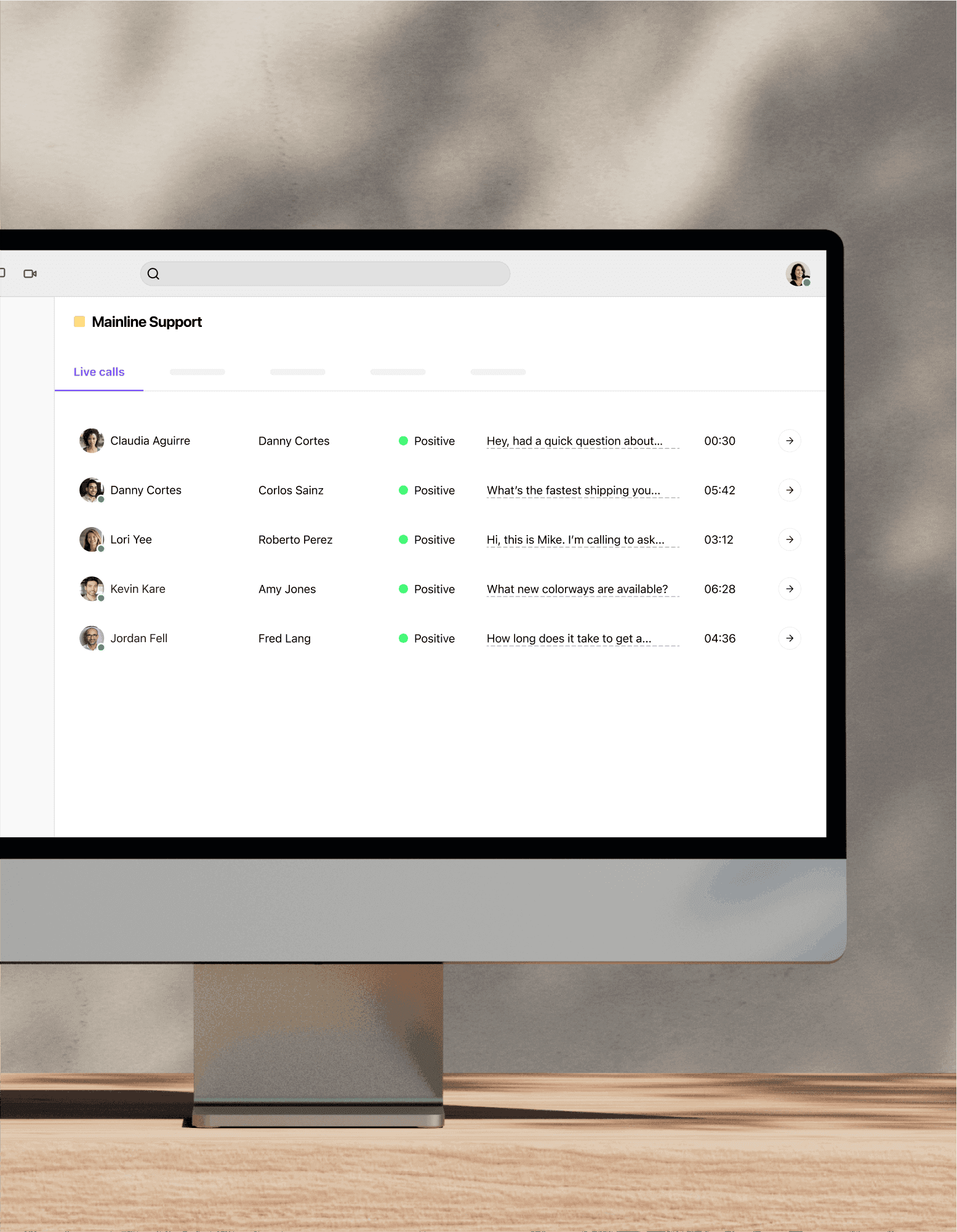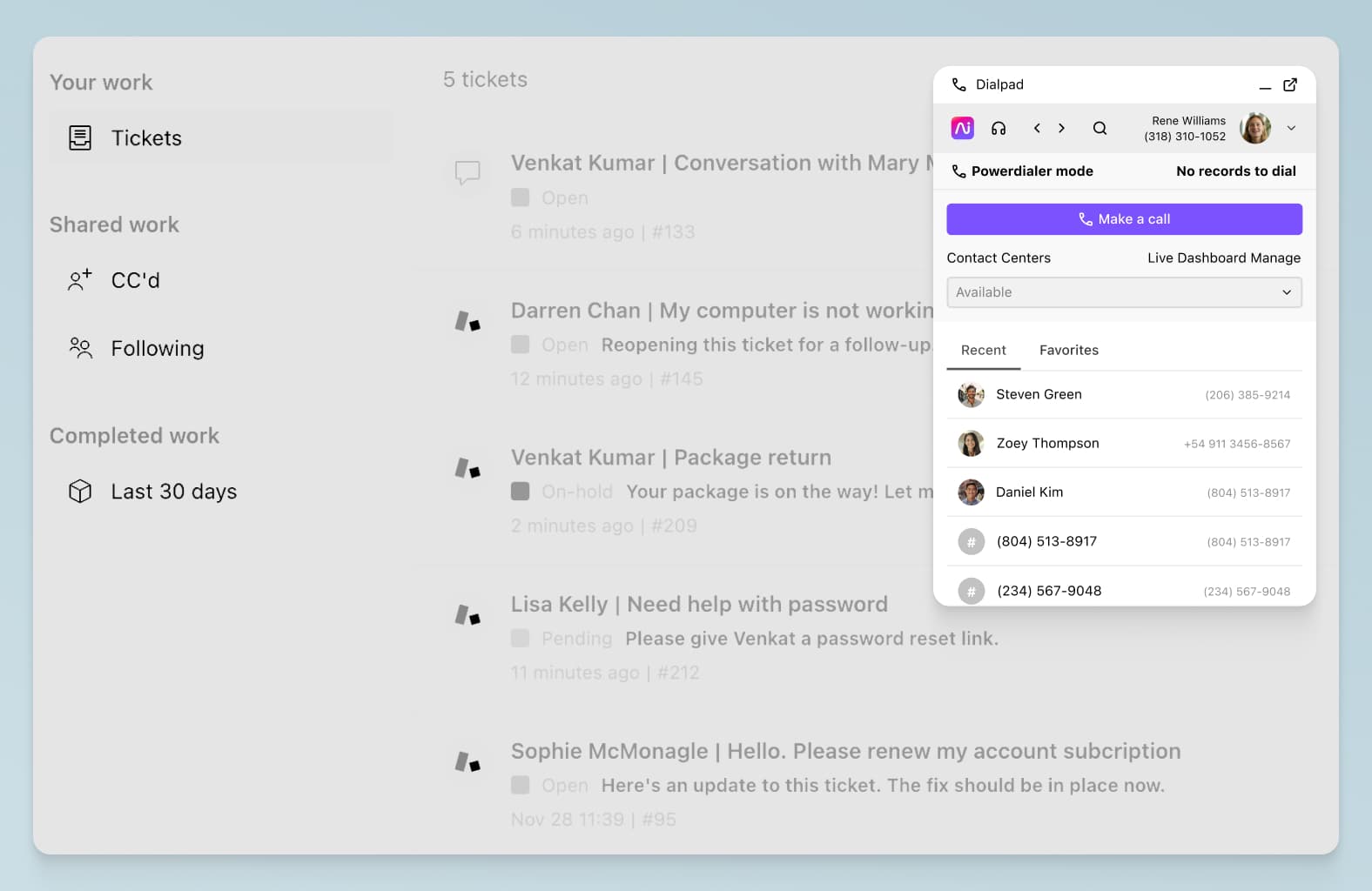Provide a better digital customer experience
Want to keep your customers happy? Keep reading. If you're looking for a contact center platform, book a product tour of Dialpad's AI-powered customer engagement platform to see how it's designed to help agents and supervisors manage all external and internal channels in one place!

The customer experience (CX) used to be simple: attract your audience with promotional materials like TV and print ads. Then it’s time to meet, greet, and close the sale at a brick-and-mortar location.
Today, the customer journey is often mostly (or fully) digital. Customer expectations are much higher and customer service teams have to balance multiple objectives. Tools like artificial intelligence are driving website personalization to help bring customer experience to the next level.
Customers aren’t interested in just your products and services anymore. They want to know what your company represents and what your customer support after the purchase looks like. They expect to be delighted at each and every physical and digital touchpoint.
So, how can you be a truly customer-centric business that provides good digital customer experiences?
What is the “digital customer experience?”
The digital customer experience (sometimes called the DCX) involves every online touchpoint your audience has with your brand on their mobile devices, computers, and tablets. This includes digital customer engagement platforms and channels like email, your website, SMS/MMS messaging, and social media—and also digitally connected environments such as the Internet of Things (IoT) and voice-activated devices.
What great digital customer experience looks like
Convenient
Fancy features aside, a great digital customer experience has to be convenient and efficient. That’s one of the biggest reasons why people tend to favor digital channels over traditional in-person channels, after all.
There’s no point having a chatbot if your customers would rather chat with live agents instead (most do).
One interesting trend is that in some industries, companies are finding that customers are more responsive to SMS or messaging rather than phone calls—it’s just more convenient for them. If you’ve ever received a confirmation for your haircut or dentist appointment via text, you know what we mean. (And if you haven’t yet, you may very soon!)
👉 Food for thought:
Is texting a digital experience—or a traditional experience?
Personalized
Netflix has become part of modern life. And sometimes it feels like the streaming service has a better idea of what we want to watch than we do!
Of course, Netflix keeps track of what we watch and offers suggestions. But it also places shows you’ve already been watching in plain view on your home dashboard. And for those customers who really enjoy Netflix’s recommendations, they’ve found a simple solution: if you like something you watch, just click the little thumbs-up option!
This type of personalization is quite simple (although the analytics behind the recommendations most likely isn’t) and it allows you to browse categories like “Gems for You” or just click on “Play Something” and let Netflix choose for you:

By giving customers the fix they need promptly, Netflix is making sure that their customers will keep coming back.
Reliable
Lastly, a good digital customer experience should be reliable. If someone is calling you about customer support, they should receive the same level of help and the same quality of service as they would’ve received if they reached out on email or live chat.
Your experience on digital channels has to be consistent with your other channels!
Transforming the customer experience through metrics: how and what to measure
First, you have to know what to measure.
If we’re talking about the digital customer experience, we can probably start with a few key places to look:
Your company’s website
Live-chat (which will usually live on your website)
Third party review sites where your customers will write about your products or services
Social media channels your customers are active on
Once you know what to measure, then you can start tracking customer touchpoints and things like website traffic, usability, and visitor behavior.
Customer engagement metrics like Net Promoter Score (NPS), Customer Satisfaction (CSAT) score, and Customer Effort Score (CES) can all help to monitor your digital CX along the customer journey.
✨ How did these contact centers provide a good CX?
Grab the Contact Center Playbook, which breaks down everything you need to know, from setup to staffing to optimizing—with examples from real contact center teams across different industries.
Businesses typically measure CSAT through customer feedback surveys after you’ve had an interaction with a customer. (This can be over the phone or in an email.)
For example, Dialpad allows you to create a CSAT survey that automatically plays after a call:

(You can customize the script, and even give your customers the option to elaborate on why they gave you the score they did.)
From there, it’s best to have some kind of analytics software or functionality that can take your customer feedback scores and map them out in a graph so you can keep track of how you’re doing over time.
Here’s the analytics screen in Dialpad, for example:

How digital transformation is influencing the customer experience
The ease of digital shopping has opened many doors for ecommerce. And more customers are spending time shopping online than ever before. It used to be that your customers could really only complain and interact with you in your store or on the phone.
Now, they want to interact with your brand from anywhere and at any time. And often, the channels that are the most convenient for them are digital channels. Which means your customer experience has to encompass all of these digital interactions too.
It’s not easy—but if you have a good digital customer experience, it can be a key brand differentiator for you.
🤠 Further reading:
See how Tecovas, one of the flyest western boots and accessories brands, provides a holistic customer experience that spans both digital and traditional channels—just the way their customers like.
Provide a better digital customer experience
From phone calls to live chat to emails, Dialpad is designed to help you communicate better with your customers. Book a demo, or take a self-guided interactive tour of the app on your own!
3 digital customer experience strategies to get you up and running
1. Don’t neglect non-digital channels! (Let customers reach you through their preferred channels)
One pitfall that many businesses forget about when designing a digital customer experience is that they forget about the customers who reach out on multiple channels.
Some people can explain themselves more clearly over the phone, while others may prefer communicating in written messages.
You have to allow your customers to pick the channel that suits them best—and your digital experience has to play nice and complement your non-digital experience.
To do this, try to use software and platforms that streamline communications and conversations into one place. This will make it easier for your team to keep track of customers’ past interactions with your business, and find information more easily when they’re responding to a customer on the phone (or email or live chat).
For example, Dialpad has integrations with popular CRMs and help desk software, and an open API that allows you to connect it to software you’re already using. If your agents are handling customer tickets in HappyFox, they can also place or take phone calls from their HappyFox screen through Dialpad with the click of a button:

All of that conversation history is saved so that employees can see the customer context and previous conversations to ensure a personalized customer experience that doesn’t make customers repeat themselves.
👉 Fun fact:
Dialpad’s cloud contact center platform also works on both desktop and mobile app—which means agents have more flexibility and can work from home more conveniently if they want to.
2. Make sure digital service and customer support are readily available
Most people prefer to fix things themselves. And your customers will probably be no different. This is actually where you can really shine as a business that provides an excellent digital customer experience.
Two essentials? Give your customers accessible self-service options like an online knowledge base and FAQs for customer support. Your customers should be able to find answers to most basic questions on their own without having to talk to someone on your team.
But again, not all customers will want to do this, so it’s important to combine good self-service options with other channels. If someone really needs to talk to you on the phone (maybe it’s about a difficult insurance claim), they should have that option.
Which would then mean that you should have a good Interactive Voice Response (IVR) system to route inbound calls and serve your customers 24/7—even when no agents are available!
👉 Dialpad tip:
Once you’ve attracted your target audience, how can you personalize each shopper’s experience? One of the benefits of digital channels is that there are automations that make it easier for you to gather data about your customers’ behaviors and segment customers by product lines or preferences. Even with offline channels like phone calls, you sometimes have “intelligent routing” options that detect a known phone number that a customer is calling from—and route them to the right department or agent automatically instead of making them sit in a queue. Neat, eh?
3. Design easy-to-navigate digital spaces
Your existing and potential customers should be able to find what they’re looking for effortlessly and accomplish their goals. In most cases, this will mainly apply to your company’s website.
If you have an app or other online spaces or communities, this would be applicable there too.
To ease the friction of customer pain points on your website, here are a few guidelines to follow:
Aim for simplicity—look at your navigation and menus
Optimize your website for mobile and smart devices
To optimize your website for mobile, consider using accelerated mobile pages, also known as AMP pages (template AMPs can be found from many sources, and they’ll help you build light and fast-loading web content)
For lead generators and important purchase or conversion pages, calls to action (CTAs) should be large, bold, and highly visible. (CTAs can range from low-commitment tasks like email signups and free trials to “Buy Now” buttons.)
5 key digital customer experience trends to watch out for
As technology evolves, your DCX should only improve. As of right now, here are some trends and themes to be aware of—you don’t have to use them all, but you may want to incorporate any combination of these into your customer experience strategy.
1. Real-time data
One big advantage of being on digital experience platforms is that it’s easier to get access to real-time data about your customer experience.
Want to have your customer data automatically pop up on agents’ screens when they’re on a call with them? You can get that with the right software and tools. For example, Dialpad’s integration with Zendesk does exactly this.
Your agents can be in their Zendesk screen, while on a phone call with a customer, while they’re logging any important details in their records—and calls are automatically transcribed too, in real time:

“But what about customers who are emailing us?” There are integrations for that, too!
For instance, Front (a shared inbox management platform) also integrates with Dialpad to let you message teammates and make phone calls from the Front interface. Integrations like these aren’t just fancy bells and whistles—they play a large role in allowing customer experience teams to get more done quickly, without switching back and forth between applications and windows.
This in turn means that your customers are getting answers and resolutions to their issues more quickly when they reach out to you, regardless of channel—and ultimately creates not only a better digital customer experience, but also a better overall customer experience.
🥡 The takeaway:
Find a way to give your agents information and customer data in real time, as they’re helping your customers. It’ll make their jobs easier—and keep your customers happy.
2. Multichannel and omnichannel customer service
Related to the above note, today’s customers want to be able to shop and communicate with your brand through multiple channels of their choice.
For example, if you’re in insurance, your customers may favor using one channel—the phone—to communicate about claims because they might want to be able to talk to a person quickly and have to explain more complicated situations.
On the other hand, if you work at a SaaS company, you may have people who will reach out for customer support using any combination of live chat, email, social media, and phone—maybe even all four.
And it may not be fair, but many customers also expect the multichannel or omnichannel customer experience to be convenient and seamless.
🥡 The takeaway:
You have to know where your customers are trying to communicate with you.
3. Self-service
If you want to improve your customer experience across digital interfaces, then one of the first things to look at is self-service. If you start with good self-service options, this will empower your customers to seek out—and find—the solution themselves.
For the vast majority of businesses, this is your best first line of defence. It doesn’t require any human intervention on your part (you don’t have to hire call center agents to work longer hours because customers can serve themselves anytime), and it requires way less maintenance than having a team of agents answering basic or easy questions.
If you really want to go the extra mile or have diehard fans, you could have a community forum where members (not necessarily your own staff!) can answer each other’s questions—which is even more hands-off for you.
🥡 The takeaway:
Have a self-service support portal or knowledge base page on your website that answers frequently asked questions. The basics include things like your business hours and refund/return policies, but you could also take the questions you get most from customers and have answers to these!
4. Use chatbots strategically
Chatbot technology is so much better than it used to be, and AI and machine learning have come a long way. This is true. But still… A quick search in your LinkedIn or Twitter feed (or even chatting with your customers) will likely show that many people still would rather speak to a person.
But what can you do when customers expect your business to be open 24/7, and you’re not in a position to hire someone just to be online all day and night?
The truth is, the best way for most businesses to handle these inquiries is to have a chatbot handling live chat messages on your website along with having human agents and other self-service options. A multi-pronged approach like this not only helps you operationally, but also provides a better customer experience.
For example, as we mentioned earlier, you should have a super robust self-service option that can handle the bulk of the questions you’d get on your website.
Same thing for folks who may try to reach you on the phone. Often, customers will call companies, wait on hold forever, give up, then try the chatbot on the website. (Or vice versa.)
If you have a thoughtfully designed IVR system that provides basic information and routes people effectively to the right agents and departments when they do end up trying the phone (and good SLAs or service level agreements that make sure your agents pick up the phone within a minute or less to create a better experience for your customers), that can reduce your dependence on chatbots.
🥡 The takeaway:
Chatbots are an affordable option to provide 24/7 customer service and support when your agents don’t work 24/7, but they’re often not customers’ favorite way of interacting with you. In most cases, they’re best used as a last resort if you absolutely cannot provide a good customer experience in any other way because of budget or staffing constraints.
5. Habit loops
If you haven’t heard of habit loops yet, then it’s time to familiarize yourself with the concept. In simple terms, a habit loop is a neurological cycle that results in a habit.
In extreme cases, these habit loops may even fall into cases of addiction. For example, look no further than your smartphone. In a recent survey of 1,000 Americans age 18 or older:
80% of respondents check their phones within 10 minutes of waking up
83% of respondents feel uneasy leaving their phone at home
Nearly 66% check their phones up to 160 times per day
And just over 75% consider themselves addicted to their phones
(You could say that smartphones have the most “customer loyalty.”)
Why has this happened? Mobile apps are essential for things like social media, entertainment, and ecommerce. In the US, it was found that almost 90% of mobile phone time was spent on these apps.
For better or for worse, this heavy usage of mobile apps and cell phones means that your digital customer experience will have to be, well, mobile-friendly.
🥡 The takeaway:
If your website isn’t mobile-responsive, or if you have only a desktop app but no mobile app, then you might be missing out on an opportunity to allow your customers to reach you where they want.
How to start mapping your digital customer experience: The 5(-ish) customer lifecycle stages
Before you can begin to improve your customer experience, you need to map out your digital customer journey. And there are usually around four to six stages of the journey. Some companies count all five, others have only four or call these by slightly different names, but generally these are the main ones.
Awareness
Your digital customers can’t find you if they aren’t even aware that you exist. Word of mouth is traditionally one of the best ways to build awareness. But today, there are other ways to do this, including building word of mouth online (like in social media channels) and making sure your website ranks in search engines like Google.
Your marketing team can take your promotion further by engaging with media and influencers, and getting positive reviews and social mentions can also be very helpful in growing your brand and reaching new audiences.
Evaluation (or Consideration)
Once customers are aware of your brand, you can expect them to evaluate what you're selling. At this point, most people will spend time looking at customer reviews and comparing your offer to that of competitors.
If you’re a software company, your customers will probably review you on third party sites like Capterra and G2.
You have to be diligent about maintaining a consistent experience across every channel on which your brand has a presence. Make sure you respond to any mentions, questions, or reviews! This does two things:
A) Shows existing customers that their feedback is valued
B) Shows prospective customers that your business is reliable and has great customer service
Conversion
Eventually, your almost-customer will reach a decision and take action. On digital channels, this means you need to eliminate any last-minute obstacles to customer conversion.
Think of this as the online equivalent of making sure your products can be easily purchased in local retail stores where your customers are located.
Use convenient and secure online payment platforms—and track and record all customer experience data from your checkout process.
This is useful information that can give you insights about things like what products are selling well, and why people abandon their online shopping carts.
If you’re running an ecommerce contact center or business, you might also consider eliminating charges like shipping fees or having delivery options—basically, minimizing the root causes of last-minute shopping-cart abandonment.
Retention
The customer experience doesn’t just end at conversion. You have to work on retention. Providing a great customer experience post-purchase will allow you to strengthen your customer relationships by building trust. Happy and loyal customers are much more likely to refer friends, write positive reviews, and buy again in the future.
To help improve this part of the user experience, you might want to send out helpful tips and how-to guides via email, or keep your customers updated on the latest news about your company on social media. Provide valuable content to your existing customers and show them a new way to use your product or clarify anything that’s a source of frequent questions.
One important thing to remember is that the “digital” customer experience isn’t always digital! Even though we’ve got emails and live-chats today, there are still many customers who prefer to reach out to companies on the phone, for a variety of reasons.
Your retention efforts have to take this into account. For example:
Let’s say a customer messages you on live-chat on their laptop or phone, waits for an agent, and then spends five minutes explaining their issue.
But, once they’ve said all this to the live chat agent, they’re told that it’s a more complicated issue and they need to call a specific number instead.
They then spend an additional five minutes explaining the problem from scratch and, understandably, become even more frustrated.
This cycle is just a huge waste of time for both you and them.
The customer walks away from the interaction(s) with a negative impression of your brand and this bad experience can lead to not only the loss of their business but also poor reviews that might damage your brand reputation. Hey, news travels fast digitally.
How can you mitigate this?
The simplest way is to make sure instead your agents are equipped with the tools to move between these channels seamlessly. Meaning if an agent is on live chat duty, they should be able to answer questions in live chat and, if it turns out to be a hard-to-explain issue, pivot to a voice call—instead of passing that customer off to another agent who’s working the phones.
That’s exactly what Dialpad Ai Contact Center lets you do. If your company’s using Dialpad's self-service functionality to handle live chat with customers, your customer and prospects have a telephony option—just in case a phone call would be easier. And you can build these flows without any coding needed, just by dragging and dropping:

Upsell / cross-sell / referrals
Successful retention builds up your customer lifetime value (CLV) and beefs up your bottom line. Loyal customers will engage with you more on their favorite channels—and they’re going to be some of your best salespeople.
Encourage online reviews on trusted sites and social media. Make it easy for them! Email them links to pages where they can fill out reviews, invite them to interact with you on social media channels, and consider a referral program. These are all great ways to keep building engagement online with customers.
Always consider your digital CX as a part of a holistic customer strategy
Digital technology has made it possible to have more impactful and highly personalized customer interactions. But it has to be used in the right way.
There will always be customers who prefer offline channels—or a mix of both, which is more likely the case.
Take a 360-degree view of your customer experience management strategy, and make sure to use a platform that allows you to be present on different channels.
Want to provide a better experience for your customers?
Book a demo of Dialpad's AI-powered customer engagement platform to see how it works, or take a self-guided interactive tour of the app on your own first!








